How Can The CIO Drive Business Outcomes in Hospitals?
In the rapidly evolving healthcare landscape, we are witnessing a shift in traditional roles and a change in relationships. As patients become consumers of health care and the focus of healthcare models moves to improve patient outcomes and to improve population health, the various roles played by the different stakeholders in this ecosystem witness an evolution of sorts. The role of the CIO, the Chief Information Officer, is one to experience this shift in this changing environment. This shift is primarily owing to the influx of technology in the hospital ecosystem. Technology is emerging as the great enabler of efficiencies, and productivity and as healthcare delivery has adopted a preventive approach leveraging the same. With that, the role of the CIO has evolved from being a provisioner of software and hardware to the one that mandates developing a transformative IT agenda that will lead of improved business performance and better patient outcomes.
The changing role of the CIO
The role of the CIO has experienced significant shifts over the past three decades. In the 80’s and the 90’s, the CIO was the one who primarily got the network ready and got all the servers and emails going. The early 2000’s witnessed wider technology adoption where the CIO focused more on systems implementation and project management type of roles. However, with the acceptance and adoption of more sophisticated technology and the drive towards digital transformation, the CIO of today has become more strategic. The CIO is now the person who will not just manage implementations but will make sure that the right technology choices are being made in alignment with business goals.
Today, most hospitals have an IT infrastructure in place. Electronic Health Records and Hospital Management Systems are almost ubiquitous to the healthcare environment. The CIO’s, however, have to address the strategic goals of interoperability, connectivity, and innovation. With hospitals leaning in towards information science and get focused to become ‘Smart’ by leveraging sensors and technologies such as Big Data Analytics, Cloud, Artificial Intelligence, Augmented and Virtual Reality, the CIO becomes the one responsible for procuring the right set of services to assist the business requirements.
From a technology expert, the CIO has to now look at understanding what is going on in the hospital environment, analyze process gaps, identify areas of improvement, and then apply technology solutions to drive innovation and better patient outcomes in the hospital ecosystem.
As a strategic decision maker in the hospital environment, the CIO has to ensure that technology can drive business outcomes by:
Reducing costs– Technology implementations across the hospital network have a cost impact. CIO’s have to now shoulder the responsibility that the technology choices made, whether it is the employment of sensors, IoT, analytics or EHR or HIS systems, improve efficiencies and consequently help in improving costs.
Productivity impact– The CIO now is an enabler of productivity. Technology choices and technology products used in the hospital environment have to be directed from the point of usability to have a positive productivity impact. The CIO, thus, has to identify redundant processes, and usability challenges that impede technology adoption and impact employee productivity negatively as well. There is no point in having systems that are difficult to use or do not generate the right data for analytics, for example. The ultimate objective of all technology solutions is that they should help in improving staff productivity by making things simpler to manage by allowing interoperability, connectivity, and access.
Better patient outcomes and greater patient satisfaction – As the CIO becomes a strategic contributor to the hospital ecosystem, the technology decisions also have to impact patient outcomes positively and ensure greater patient satisfaction levels. CIOs are responsible for
- Employing technologies that help in better monitoring of chronic diseases
- Leveraging mobility to help the patients gain more control of their health records by enabling anywhere-anytime access
- Making sure technology at play simplifies their time at the hospitals
- Enabling data-driven decision making
- Making operational and clinical processes so streamlined and efficient that improved patient outcomes and low readmission rates become a natural consequence of their decisions.
As we move deeper into the era of innovation, technological advancements and continuous knowledge exchange, the CIO’s role demands real-world innovation experience, transformational thinking, and the ability to connect people, technology, and strategy to lead to sustainable business outcomes. Clearly, the modern-day CIO has to focus on certain areas, whether clinical, operational or administrative, that they didn’t perhaps need to in the past. The new age hospital CIO has to be more proactive and innovative to shape the IT agenda of the hospital environment, choosing the right technologies, platforms, solutions and systems, that ultimately improve performance and impact business outcomes positively.




